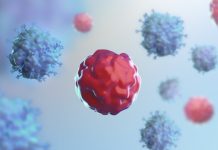
Scientists have uncovered the mechanism behind a crucial protein that causes HIV to spread. The findings may help to develop novel treatments for HIV.
Researchers from Rutgers University and the Salk Institute have collaborated to discover the molecular structure of the HIV Pol polyprotein, which is essential for the virus to spread throughout the body. The groundbreaking discovery may help to develop new treatments for HIV, a disease that affects more than 40 million people globally.
Eddy Arnold, the co-senior author of the study and a Board of Governors Professor and Distinguished Professor in the Center for Advanced Biotechnology and Medicine at Rutgers, said: “Drug molecules need a particular structure to bind specifically to their disease targets. They fit together like complex puzzle pieces. Knowing the structure of the molecule, you’re targeting helps you find or make a drug that will fit.”
The findings are published in Science Advances.
Understanding the HIV Pol polyprotein
Earlier studies demonstrated that the HIV Pol polyprotein breaks down into three enzymes known as protease, reverse transcriptase, and integrase. These enzymes work together to create the mature form of HIV.
Until now, experts did not know how the protease element breaks free from the larger protein – HIV Gag-Pol – and subsequently from the HIV Pol polyprotein. The study results suggest that protease triggers the process by self-cleaving or cutting itself free from the molecule. Understanding how it initiates the replication process may aid in designing effective treatments for HIV.
Co-first author Jerry Joe Harrison, who developed a breakthrough recipe for stable HIV Pol polyprotein as a doctorate student at Rutgers and is a senior lecturer at the University of Ghana, commented: “The first challenge was producing a stable version of the naturally transitory HIV Pol polyprotein so the structure could be analysed.”
The scientists created a stable version of the HIV Pol polyprotein using cryogenic electron microscopy, revealing its three-dimensional structure. This uncovered that the HIV Pol polyprotein is a dimer, which means it is formed by two proteins that attach together. This was a shocking discovery, as similar viral proteins are single-protein assemblies.
Dmitry Lyumkis, an assistant professor in the Laboratory of Genetics and Hearst Foundation Development Chair at Salk, said: “Structure informs function, and the insights we gained from visualising the molecular architecture of Pol give us a new understanding of the mechanism by which HIV replicates.”
Arnold commented: “An unexpected realisation was that the reverse transcriptase portion of this polyprotein precursor resembles its mature dimeric form. The HIV Pol polyprotein was one of the most important missing pieces in the HIV structural puzzle.”
New treatments for HIV
The researchers explained that their findings would enable future research, such as analysing the HIV Pol structure of the larger and more complex polyprotein Gag-Pol, which is essential in viral assembly. They will also examine the role of integrase in assembling the mature form of HIV during replication.
Dario Passos, a former researcher in Lyumkis’s lab at Salk, concluded: “Current treatments for HIV include multiple classes of inhibitors for all three enzymes, and the discovery also reveals a new vulnerability that could be targeted with drugs.”








